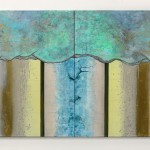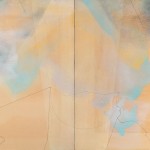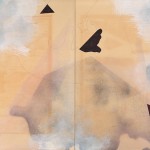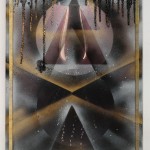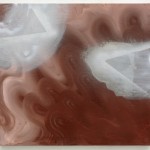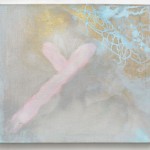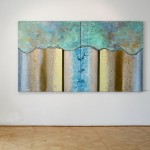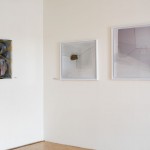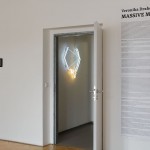MASSIVE MEMORY
Text by: PhDr. Michal Tošner, Ph.D.
About the Artist:
Veronika Drahotová employs artistic means to explore human destiny and existence. The starting point for her work is her own philosophical method of intuition for which she subsequently seeks support in the relevant sources of thought and creativity. The resulting works are not just paintings or objects, but imprints (document/monument) of exploring movement; an imprint of asking a question and the process of answering it. The artist has a predilection for systematic solutions and uses the terms of structure, rules and strategies to express herself. However, at the same time, her work is guided by a love for life, beauty and people as such (agapé); which is manifested by the recurring motif of the (burning) heart. In a certain sense, her work becomes the script of the heart (e.g. Heart Script, 2011). Her desire is to achieve pure and clear human understanding. She aims for the ideal of a pure transparency of life; which, seeming however unattainable, she refuses to accept limits, attacking the bounds of possibility and daring to try the impossible.
To her, existence is a “known unknown“; a variable in the equation of life, a mysterious “challenge of the locked chamber.” In her work, she deciphers both the enigma of existence and the ciphers of transcendence. To reveal the mystery of life, she explores the relation between pure mind and sensory perception which exposes us to the world (Amor Fati, 2009); she deals with the mental space conceived as consciousness, unconsciousness and dreaming (They Don’t Know It but They Are Doing It, 2010); she thematizes the individual consciousness which is defined by co-existence, misunderstanding and hope (They-I, 2011). She keeps exploring the relation of the intellect, the senses and matter; which is both lacking something and transcended by something (Theory of Nothing, 2013). Her exhibition Sugar Choice (2014) was dedicated to the question of freedom and the conditioned character of choice limited by the senses and the urgency of time. Temporality as the “horizon of being” was also at the root of her series Until the End of Time, If Such a Thing Exists (2014).
In her current exhibition, Massive Memory (2015), Veronika Drahotová develops her previously outlined theory of time. Here it is uncovered on the basis of the relation between consciousness conceived as memory and consciousness conceived as immediate perception. The artist encourages us to deal with the content-volume-space-movement of memory; the things we remember and the things we have forgotten; raising the question why un/certain memories become present under certain conditions.
The formal aspect of her visual expression deserves explanation as well. Since approximately 2010, Veronika Drahotová has been developing a specific “architectonic approach to painting,” which led to her invention of a unique system of interconnecting, linked paintings, which she continues to refine. The principle consists in the fact that every time the frames are turned by 90 degrees around their axis, they will “fit into each other.” They visually continue each other, composing a new variant of the painting. Although a fixed installation of the canvases does not allow us to see these versions (they can only be composed mentally), the painting itself alludes to all of its combinations; to its own dynamic scheme.
B) About the Exhibition:
MASSIVE MEMORY; what space is opened and what questions are asked by the paintings and objects herein? Memory is hardly a simple thing. Memory is a theme that opens up many questions that undoubtedly deserve intuitive exploration and its artistic expression.
I. La durée: Multiplicity of Duration within the Whole of Time
Human time is biological time; it is infinitely small when compared to geological time; the long time of the duration of mountains that almost seem eternal. However, even during a relatively short life, one can discover an immense mass of memories; the geological layers of one’s own memory; the sediments and crystals of memories whose reflections often unexpectedly invade the present consciousness, flooding it with images and feelings… However, the multiplicity of duration can only take place within a single Time.
II. La euchronicité: the Past Is Always Present
When entering memory, we always dive into the past. However, what is happening at that moment? Are we pulled out from the present? Does remembering substitute immediate perception? Not at all! The past is part of the present. What is more, the past is more real than the present. The past is a present which has passed. While the present acts and keeps escaping, the past remains. The past is concurrent with the present. In a certain sense, the past is even ahead of the present. It is only thanks to the past that we are able to perceive the present. A person without a past lacks the reality of existence. Without memories, we would not know who we are and what is happening around us. Everything is simultaneous, everything is now…
III. La spatialité: Compression and Spaciousness
The past is a dimension of space. The whole of the past is compressed and spacious at the same time. The artist deliberately decompresses this space to reveal its massiveness. Dominant memories are the key points. They are the peaks, levels and layers that organize the whole space of the past. Following a memory means moving vertically between the individual levels, estimating one’s position with respect to the dominants, looking for one’s way. However, the immobility of the past is only imaginary; a memory can be within reach but can also be missed. The way towards it can be blocked, it can be compressed in narrow passes, hidden in the folds, buried by another mass of the past. It can turn out as being too remote or scattered on vast plains.
IV. Le dynamisme: Memory as Movement and Movement through Memory
If memory is a space, then there must be movement in it; it is dynamic. Memory creates a mass of memories some of which may become present in consciousness. It contains a “dynamic scheme” that can be grasped in the form of a massive mountain, a pyramid or a cone. Each memory requires movement from its quiet repose in unconsciousness towards becoming present. What happens here is a shift from virtuality to actuality; the past is pulled into the present. Remembering constitutes consciousness as such…
Remembering requires mental movement; moving from the past to the present, from remembering to perceiving. Recollecting has certain stages or degrees. We have to descend to a certain level where the memory lies and pull it, along with its level, to our consciousness. Then the memory must be “translated” and linked to the present. It becomes fully present at the moment an image is produced.
Remembering also requires external movement, as it follows after a certain challenge corresponding to the needs of the present situation. The memory must be positioned so as to fit the presence or the context of other remembered images: “memories that are becoming present are in a state of mutual penetration; they are developed into distinct, mutually external images corresponding to the individual memories…”.
V. La conclusion visuelle: Representation of the Space of Memory
Several new wholes, with their own consistent plans, can be set up in this way. As a result, the painting on the canvas escapes its frame and enters another painting. Two canvases can form four different variants; four wholes with a different meaning, focus and energy. Once arranged in a certain way, the three remaining variants of the painting represent virtualities of the current setup. The artist has consciously gone through all of these singular variants while making the object. This principle is a perfect illustration of the fact that the past states that were once an actuality and are now a virtuality can be recalled. They are modular paintings containing the principle of rotation. They can offer the most effective constellation with respect to the situation. The paintings of Veronika Drahotová are images of the co-existence of the present and the past, alluding to the multiplicity of duration within a single whole of Time.*
* The author of the text would like to thank M. Proust, H. Bergson and G. Deleuze as well as the artist.
Massive Memory
Text k výstavě: PhDr. Michal Tošner, Ph.D.
O autorce:
Veronika Drahotová uměleckými prostředky provádí průzkum lidského údělu a existence. Východiskem tvorby je jí vlastní filozofická metoda intuice, pro kterou až následně hledá opory v relevantních zdrojích myšlení a tvorby. Výsledná díla tak nejsou jen tím, co je přítomno ve formě obrazu nebo objektu. Samotné dílo je otiskem (dokumentem/monumentem) zkoumajícího pohybu, otiskem kladené otázky a procesu jejího zodpovídání. Autorka projevuje náklonnost k systematičnosti a vyjadřuje se v pojmech struktury, pravidel a strategií. Avšak její tvorba je současně vedena láskou k životu, ke kráse a k lidem jako takovým (agapé), což se projevuje neustále se navracejícím motivem (planoucího) srdce. Její dílo se v jistém smyslu stává písmem srdce (např. Heart Script, 2011). Její touhou je dosáhnout mezilidského porozumění v jasnosti a zřetelnosti. Míří k ideálu čisté transparence života, jež se však ukazuje jako nedosažitelná. Odmítá akceptovat tyto limity, útočí na samu hranici a odvážně se pokouší o nemožné…
Nastolenou teorii času rozvíjí i v aktuální výstavě Massive Memory (2015). Zde je odkrývána na vztahu mezi vědomím jakožto pamětí a vědomím jakožto bezprostředním vnímáním. Autorka tak nabádá k tomu, abychom se zabývali obsahem-objemem-prostorem-pohybem paměti, tím, co si pamatujeme a tím, co jsme zapomněli, přivádí nás k otázce, proč se nám za jistých podmínek aktualizují ne/určité vzpomínky.
Pozornost zasluhuje i samotná formální stránka jejího výtvarného výrazu. Přibližně od roku 2010 rozvíjí specifický „architektonický přístup k obrazu“, který ji přivedl k invenci unikátního systému propojovaní/navazování obrazů, jejž dále precizuje. Princip spočívá v tom, že pokaždé, když se otočí rámy kolem své osy o devadesát stupňů, „zapadají do sebe“. Vizuálně navazují a složí se v novou variantu obrazu. I když fixní instalace pláten neumožňuje tyto verze vidět (lze si je jen skládat v představě), sama malba odkazuje ke všem svým kombinacím, k vlastnímu dynamickému schématu.
O výstavě:
MASSIVE MEMORY – do jakého prostoru a k jakým otázkám nás zavádí obrazy a objekty zastřešené tímto názvem? Paměť rozhodně není něco jednoduchého. Paměť je téma, skrze nějž se otvírá řada otázek, jež bezpochyby zasluhují intuitivní zkoumání a jejich umělecká vyjádření.
I. La durée: multiplicita trvání v celku Času
Lidský čas je časem biologickým, jenž je nekonečně malý, je-li poměřován časem geologickým, dlouhým časem trvání hor, jež se jeví jakožto věčné. Avšak i uvnitř relativně krátkého života lze objevit nezměrnou masu vzpomínek, geologické vrstvy vlastní paměti, sedimenty a krystaly vzpomínek, jejichž odlesky mnohdy nečekaně protnou aktuální vědomí a zaplaví je obrazy a city… Mnohost trvání se však odehrává v jediném Čase.
II. La euchronicité: minulost je stále přítomna
Vstupujeme-li do paměti, provádíme skok do minulosti. Co se ale v tu chvíli děje? Vytrháváme se z přítomnosti? Nahrazuje vzpomínání bezprostřední vnímání? Nikoli! Minulost je součástí přítomnosti. Ba co víc, minulost je více skutečná než přítomnost. Minulost je přítomnost, jež minula. Zatímco přítomnost působí a stále uniká, minulost zůstává. Minulost je současná s přítomností. V jistém smyslu je minulost dokonce v předstihu před přítomností. Jen díky minulosti jsme schopni vnímat přítomnost. Člověk bez minulosti postrádá reálnost existence. Bez vzpomínek bychom nevěděli, kým jsme a co se kolem nás právě odehrává. Vše je simultánní, vše je teď….
III. La spatialité: komprese a rozlehlost
Minulost je dimenzí prostoru. Celek minulosti je zároveň stlačený a zároveň rozlehlý. Umělkyně tento prostor záměrně dekomprimuje, aby vyjevila jeho masivnost. Dominantní vzpomínky jsou význačnými body. Jsou to vrcholy, roviny a vrstvy, které celý prostor minulosti organizují. Vydat se za vzpomínkou znamená pohybovat se vertikálně mezi úrovněmi, odhadovat svou polohu vzhledem k dominantám, hledat cestu. Ale nehybnost minulosti je zdánlivá, vzpomínka je na dosah, ale můžeme jí minout. Cesta k ní může být zatarasena, může být stlačena v soutěskách, skryta v záhybech, zavalena jinou hmotou minulosti. Může se ukázat jako příliš vzdálená nebo rozptýlená na rozlehlých pláních.
IV. Le dynamisme: paměť jako pohyb a pohyb pamětí
Je-li paměť prostorem, je v ní nutně pohyb, je dynamická. Paměť vytváří masu vzpomínek, z nichž některé mohou nabýt zpřítomnění ve vědomí. Obsahuje v sobě „dynamické schéma“, jež lze uchopit v podobě masivní hory, pyramidy nebo kužele. Každá vzpomínka vyžaduje pohyb od svého tichého spočívání v nevědomí k vlastnímu zpřítomnění. Uskutečňuje se zde přechod z virtuality do aktuality, minulost je vtažena do přítomnosti. Vzpomínání zakládá vědomí jako takové…
Vzpomínání vyžaduje náš vlastní psychický pohyb. Pohyb, v němž jdeme od minulosti k přítomnosti, od vzpomínky ke vnímání. Rozvzpomínání má jisté etapy či stupně. Musíme sestoupit na určitou rovinu, na níž se vzpomínka nachází, a vtáhnout ji s celou touto rovinou do vědomí. Pak musí být vzpomínka „přeložena“ a připojena k přítomnosti. Plné aktualizace dosáhne ve chvíli, kdy dojde k vyvolání obrazu.
Vzpomínka vyžaduje i vnější pohyb, neboť se objevuje na určitou výzvu, která odpovídá potřebám přítomné situace. Musí být pootočena tak, aby zapadala do přítomnosti či do kontextu dalších vzpomínek obrazů: „aktualizující se vzpomínky jsou ve stavu vzájemného pronikání, a rozvíjíme ji do zřetelných, navzájem vnějších obrazů, jež odpovídají té či oné vzpomínce…“.
V. La conclusion visuelle: zobrazení prostoru paměti
Lze tak sestavit několikráte nový celek s vlastním plánem konzistence. Obraz na plátně v důsledku uniká ze svého rámu a zasahuje do jiného obrazu. Ze dvou pláten lze sestavit čtyři různé varianty, čtyři celky s různým vyzněním, těžištěm a nábojem. Další tři varianty obrazu jsou virtualitami vůči aktuálnímu nastavení. Všechna sestavení autorka prováděla ve fázích tvorby tohoto objektu. Tento princip skvělým způsobem ukazuje, že minulé stavy, které byly aktualitou a staly se virtualitou, mohou být přivolány zpět. Jsou to modulární obrazy obsahující rotační princip. Vzhledem k situaci mohou nabídnout nejúčinnější konstelaci. Obrazy Veroniky Drahotové jsou obrazem koexistence přítomnosti a minulosti, odkazují k multiplicitě trvání v jediném celku Času. *
*Autor textu děkuje M. Proustovi, H. Bergsonovi a G. Deleuzeovi, jakož i autorce pojednávaných uměleckých děl.


